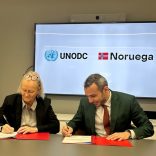Mozambique: Over 113,000 Cabo Delgado families displaced by rebels need support - Watch
Cabo Delgado: Eleven days at sea in search of safety

Photo: O País
Since March 24th, the day of the terrorist attack, the lives of those who lived in the town of Palma have been marked by tragedy, despair, and setbacks. Since then, day after day, dozens of people embarked or tried to embark, by land or by sea, in search of refuge from the terrorists.
A month after the attack on Palma, the capital of Cabo Delgado, Pemba, continues to receive displaced people from Palma.
This Tuesday (April 20), more than 100 people arrived in Paquitequete in two sail boats. They brought with them the very little they had managed to salvage and carry during their escape, but a quantity of dramatic stories about the long journey that took them far from their homes.
“From Palma to Pemba, it took us 11 days, because of the bad weather, especially the wind, which pushed our boat out into the open sea,” said 45-year-old Fatua Adamo, disembarking in Paquite with her husband and six young children.
Continuing the chronicle of the “long and tiring trip,” Mandrasse Sumail, another newly-arrived Palma resident, said that the expedition by sea was dogged with uncertainties, risk and the imminent possibility of tragedy.
“[When) we left Palma, [we were] 131 people in one [single] boat. During the trip, our boat broke up, but luckily near an island, which we managed to swim to. There, we found two smaller boats, and split up. That’s how we arrived in Pemba,” said 20-year-old Mandrasse, who, having survived several attacks, eventually fled from Quissengue village.
The biggest problem of the trip, the displaced said, was hunger and lack of drinking water, and they only managed to survive “thanks to people of good will.”
“We suffered a lot with rain, day and night. We would only eat when we found an island, where we asked for help in food and water. We would cook, eat, and gain strength to continue with the journey,” Sumail recounted.
The displaced have not specifically confirmed any of the recent attacks, saying only that they fled out of fear and panic caused after the March 24 attack on Palma town, which left several neighbouring villages virtually deserted.
“Almost all villages, including Quissengue, where we are from, are abandoned. Everyone is concentrated in Quitupo, near the Total camp, waiting for an opportunity to leave Palma [district],” revealed Abdul Inze, one of the more than 130 displaced people who arrived in Palma on Tuesday.
The IDPs, mostly women and children, were received by the Defence and Security Forces (FDS), who directed them to transitional accommodation centres, with the exception of those who found family members right away.
Mapping the displaced
A survey by the United Nations High Commissioner for Refugees (UNHCR) indicates that Mueda district has been the commonest place of refuge for those fleeing Palma.
Based on data figures to April 15, the UNHCR survey indicated that 33% of the approximately 20,000 registered people fleeing recent attacks ended up in Mueda, a district more than 250 kilometres distant.
In Nangade, the district immediately adjacent to Palma, is hosting 26% of the displaced, followed by Pemba with 19%, Montepuez with 17%, and Chiúre, further south, with 3% of the displaced.
Of the total number of IDPs, the UNHCR reveals that 74% are hosted by local communities, and that, of the recent wave of refugees from Palma, 43% are children, of whom over 260 are unaccompanied by any family member.
By Hizidine Achá













Leave a Reply
Be the First to Comment!
You must be logged in to post a comment.
You must be logged in to post a comment.